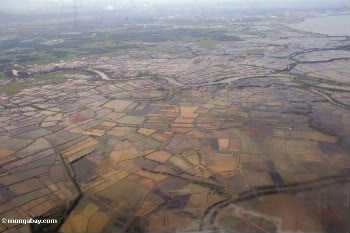In 1999 a super cyclone struck the eastern coast of India, leaving 10,000 people dead. At the time, the Orissa cyclone, named after the Indian state which it battered, was the deadliest storm in India in over a quarter century. However, according to a new study published in The Proceedings of the National Academy of Sciences the death toll would have been significantly higher if the mangrove forests buffeting the Indian villagers from the sea had not softened the cyclone’s blow.
Researchers from the University of Delhi and Duke University analyzed death tolls from 409 villages in the largely rural Kendrapada District. They compared each village’s mortality rates with the width of mangrove forests between the village and the open sea. Using statistical models, the researchers found that if mangroves had been lost entirely, deaths per village would have increased by 1.72.
 Mangroves replaced by rice fields in Indonesia. Photo by: Rhett A. Butler. |
“This is a measure of the life-saving impact of the mangroves that remained in 1999. It implies that they cut the death toll by about two-thirds,” said Jeffrey R. Vincent, Professor of Forest Economics and Management at Duke’s Nicholas School of the Environment. “Taking other environmental and socioeconomic factors into account, villages with wider mangroves suffered significantly fewer deaths than ones with narrower or no mangroves.”
By 1999 the Kendrapada District had deforested nearly half of its mangrove forests for producing rice. The average width of mangrove forests between villages and the coasts dwindled from 5.1 kilometers (just over 3 miles) to 1.2 kilometers (0.7 miles). The village with less deforestation clearly fared better according to the study.
“Our analysis shows a clear inverse relationship between the number of deaths per village and the width of the mangroves located between those villages and the coast,” says Vincent. “We believe this is the first robust evidence that mangroves can protect coastal villages against certain types of natural disasters.”
Scientists have long debated the role mangroves play in saving lives from extreme weather. The debate heated up after the 2004 tsunami in the Indian Ocean. Vincent cautions that this study only points to the life-saving aspects of mangroves during cyclones, not tsunamis, since tsunamis cause different wave dynamics, including longer wave lengths.
Related articles
How to replant a mangrove forest: local, low-cost initiatives prove most successful
(07/23/2008) Mangrove replanting and rehabilitation has become a widespread and important environmental initiative worldwide. Mangrove forests play key ecological roles, including sustaining fish populations and other wildlife, preventing erosion along coastlines, and acting as an overall carbon sink. Furthermore, mangroves have received attention lately for their role in providing an effective buffer against typhoons. In light of the many replanting initiatives now occurring, researchers J.H. Primavera and J.M.A. Esteban conducted a study of the overall effectiveness of different mangrove rehabilitation schemes. Their findings show that small, local, and generally cheaper initiatives have a higher success rate over large costly government and international programs.
Mangroves are key to healthy fisheries, finds study
(07/21/2008) Mangroves serve as a critical nursery for young marine life and therefore play an important role in the health of fisheries and the economic well-being of fishermen, report researchers writing in the early online edition of the Proceedings of the National Academy of Sciences.
Massive deforestation of mangroves may have worsened scale of disaster in Burma
(05/13/2008) Weeks after the devastating cyclone Nagris struck Myanmar’s Irrawaddy Delta on May 2nd, scientists and the media are debating the role in the scale of the disaster played by the region’s deforestation of mangroves. According to recent studies, mangrove forests act as a buffer against the effect’s of tropical storms like Nagris, though scientists don’t yet fully understand the relationship between storm mitigation and mangroves.
Agriculture is primary driver of mangrove destruction
(10/31/2007) Agricultural expansion — not shrimp farming — is driving the rapid destruction of the world’s mangrove forests, reports a new study published in the Journal of Biogeography.
Mangroves more threatened than rainforests
(07/05/2007) Destruction of mangrove forests could leave the world deprived of their important ecological services by the end of a century, warns an international team of scientists writing in the July 6th issue of the journal Science.
20% of the world’s mangroves lost since 1980
(11/11/2005) 20% of the world’s mangrove forests have disappeared since 1980 according to a new study by the Food and Agriculture Organization of the United Nations (FAO).













